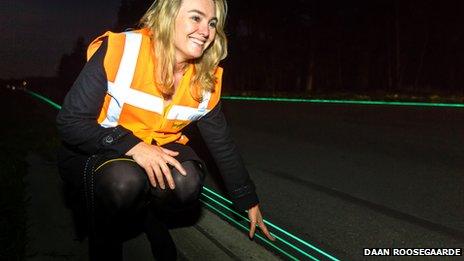Glowing 'smart cycle lanes' are pitched to UK
- Published

A stretch of glow-in-the-dark road markings has been installed in the Netherlands after being proposed as one of several "smart highway" features that could be put to wide use.
Route 66 of the Future uses special green paint, charged by daylight.
It is designed to be clearer than existing cat's eye reflective spheres.
Its creators are also due to test glow-in-the-dark cycle lanes, which they said had already attracted the interest of UK planners.
"The glowing lines are a little ... Daft Punk look-alike but they are to do with safety," said artist Daan Roosegaarde, one of the road markings' designers.
"The three lines merge into one and you feel that it guides you. With fog, you see them more than with standard light,"
He has worked on the project - and many others - with Hans Goris, a civil engineer at infrastructure firm Heijmans.
"There is much less energy used," said Mr Roosegaarde of the photo-luminescent paint he uses.
"There will be big projects, we have requests from China and India - these are places where you need safe roads that are disconnected from the energy grid."
A stretch of road at Oss, near Nijmegen in the south of the country, is being used to showcase the design.
Their first cycle highway, called the Van Gogh-Roosegaarde Light Emitting Bicycle Path, is due to be launched in December in Nuenen, which was once home to the Dutch post-impressionist artist.
According to Mr Roosegaarde, it was inspired by Van Gogh's masterpiece "Starry Night". He said he had demonstrated the technology to authorities from Birmingham and London earlier this month.
Both, he said, were due to watch follow-up tests in the coming months with a view to introducing the innovation to the UK.
Prof David Bailey, an automotive expert at Aston Business School in Birmingham, backed the idea of a test to see it it truly made cyclists more visible at night and encouraged motorists to give them more space.
"The Netherlands is much better organised than the UK, they have a much better laid-out network of highways," he commented.
"It is a good idea to try it, though.
"There is a possibility of reducing electricity use as well."
Mr Roosegaarde said that his team had around 20 ideas that it wanted to try to implement over a five-year period.
He was speaking from Beijing, where he said he was constructing a "smog-free park by building the largest vacuum cleaner in the world".
"We think half of the ideas will influence roads in the future to make them energy neutral and functional," he added.
"It is not just an artwork, we want to update reality."
'Great connection'
He also remarked that Britain's tradition of blending craftsmanship and function made it a perfect place to install his cycle highway.
"For a small country like the Netherlands, we have to be creative - that is how we will survive. I won't say what the UK should and shouldn't do but I can see similarities. You cherish your heritage but you want to make it contemporary too.
"There is a great connection between the art and the technical in Britain - the Spitfire is a good example."
He said he hoped that, if the project went ahead, it would be finished within two years.
Both the Mayor of London's office and Birmingham Council were contacted about the tests but neither were able to confirm plans to send a delegation.
- Published1 May 2013
- Published21 March 2013
- Published19 March 2013